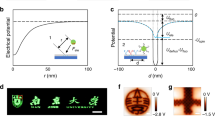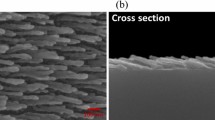Abstract
Enhanced Raman scattering from metal surfaces has been investigated for over 30 years1. Silver surfaces are known to produce a large effect, and this can be maximized by producing a roughened surface, which can be achieved by the aggregation of silver nanoparticles2,3,4. However, an approach to control this aggregation, in particular through the interaction of biological molecules such as DNA, has not been reported. Here we show the selective turning on of the surface enhanced resonance Raman scattering5 effect on dye-coded, DNA-functionalized, silver nanoparticles through a target-dependent, sequence-specific DNA hybridization assembly that exploits the electromagnetic enhancement mechanism for the scattering. Dye-coded nanoparticles that do not undergo hybridization experience no enhancement and hence do not give surface enhanced resonance Raman scattering. This is due to the massive difference in enhancement from nanoparticle assemblies compared with individual nanoparticles. The electromagnetic enhancement is the dominant effect and, coupled with an understanding of the surface chemistry, allows surface enhanced resonance Raman scattering nanosensors to be designed based on a natural biological recognition process.
This is a preview of subscription content, access via your institution
Access options
Subscribe to this journal
Receive 12 print issues and online access
$259.00 per year
only $21.58 per issue
Buy this article
- Purchase on Springer Link
- Instant access to full article PDF
Prices may be subject to local taxes which are calculated during checkout




Similar content being viewed by others
References
Fleishman, M., Hendra, P. J. & McQuillan, A. J. Raman spectra of pyridine adsorbed at a silver electrode. Chem. Phys. Lett. 26, 163–166 (1974).
Munro, C. H., Smith, W. E., Garner, M., Clarkson, J. & White, P. C. Characterization of the surface of a citrate-reduced colloid optimized for use as a substrate for surface-enhanced resonance Raman scattering. Langmuir 11, 3712–3720 (1995).
Nie, S. & Emory, S. R. Probing single molecules and single nanoparticles by surface-enhanced Raman scattering. Science 275, 1102–1106 (1997).
Faulds, K., Littleford, R. E., Graham, D., Dent, G. & Smith, W. E. A comparison of surface enhanced resonance Raman scattering (SERRS) from unaggregated and aggregated nanoparticles. Anal. Chem. 76, 592–598 (2004).
Stacy, A. M. & Van Duyne, R. P. Surface enhanced Raman and resonance Raman spectroscopy in a non-aqueous electrochemical environment: Tris(2,2′-bipyridine)ruthenium(II) adsorbed on silver from acetonitrile. Chem. Phys. Lett. 102, 365 (1983).
Stokes, R. J. et al. Quantitative enhanced Raman scattering of labeled DNA from gold and silver nanoparticles. Small 3, 1593–1604 (2007).
Jeanmarie, D. L. & Van Duyne, R. P. Surface Raman spectroelectrochemistry, part 1: Heterocyclic, aromatic, and aliphatic amines adsorbed on the anodized silver electrode. J. Electroanal. Chem. 84, 1–20 (1977).
Kneipp, K., Kneipp, H., Itzkan, I., Dasari, R. R. & Feld, M. S. Ultrasensitive chemical analysis by Raman spectroscopy. Chem. Rev. 99, 2957–2976 (1999).
Cunningham, D. et al. Practical control of SERRS enhancement. Faraday Discuss. 132, 135–145 (2006).
McHugh, C. J., Docherty, F. T., Graham, D. & Smith, W. E. SERRS dyes. Part 2. Synthesis and evaluation of dyes for multiple labelling for SERRS. Analyst 129, 69–72 (2004).
Michaels, A. M., Jiang, J. & Brus, L. Ag nanocrystal junctions as the site for surface-enhanced Raman scattering of single Rhodamine 6G molecules. J. Phys. Chem. B 104, 11965–11971 (2000).
Faulds, K., Smith, W. E., Graham, D. & Lacey, R. J. Assessment of silver and gold substrates for the detection of amphetamine sulfate by surface enhanced Raman scattering (SERS). Analyst 127, 282–286 (2002).
Alivastos, A. P. et al. Organization of ‘nanocrystal molecules’ using DNA. Nature 382, 609–611 (1996).
Huang, C. C., Huang, Y. F., Cao, Z., Tan, W. & Chang, H. T. Aptamer-modified gold nanoparticles for colorimetric determination of platelet-derived growth factors and their receptors Anal. Chem. 77, 5735–5741 (2005).
Mirkin, C. A., Letsinger, R. L., Mucic, R. C. & Storhoff, J. J. A DNA-based method for rationally assembling nanoparticles into macroscopic materials. Nature 382, 607–609 (1996).
Braun, G. et al. Surface-enhanced Raman spectroscopy for DNA detection by nanoparticle assembly onto smooth metal films. J. Am. Chem. Soc. 129, 6378–6379 (2007).
Cao, Y. C., Jin, R. & Mirkin, C. A. Nanoparticles with Raman spectroscopic fingerprints for DNA and RNA detection. Science 297, 1536–1540 (2002).
McAnally, G. et al. SERRS dyes. Part I. Synthesis of benzotriazole monoazo dyes as model analytes for surface enhanced resonance Raman scattering. Analyst 127, 838–841 (2002).
Storhoff, J. J., Elghanian, R., Mucic, R. C., Mirkin, C. A. & Letsinger, R. L. One-pot colorimetric differentiation of polynucleotides with single base imperfections using gold nanoparticle probes. J. Am. Chem. Soc. 120, 1959–1964 (1998).
Demers, L. M. et al. A fluorescence-based method for determining the surface coverage and hybridization efficiency of thiol-capped oligonucleotides bound to gold thin films and nanoparticles. Anal. Chem. 72, 5535–5541 (2000).
Acknowledgements
The authors wish to thank the Analytical Trust Fund of the Royal Society of Chemistry for the award of the Analytical Grand Prix to D.G.
Author information
Authors and Affiliations
Contributions
All authors discussed the results and commented on the manuscript. D.G.T. performed all the experiments.
Corresponding author
Supplementary information
Rights and permissions
About this article
Cite this article
Graham, D., Thompson, D., Smith, W. et al. Control of enhanced Raman scattering using a DNA-based assembly process of dye-coded nanoparticles. Nature Nanotech 3, 548–551 (2008). https://doi.org/10.1038/nnano.2008.189
Received:
Accepted:
Published:
Issue Date:
DOI: https://doi.org/10.1038/nnano.2008.189
This article is cited by
-
Photochemical synthesis of pink silver and its use for monitoring peptide nitration via surface enhanced Raman spectroscopy (SERS)
Amino Acids (2022)
-
Monitoring peptide tyrosine nitration by spectroscopic methods
Amino Acids (2021)
-
Direct SERDS sensing of molecular biomarkers in plants under field conditions
Analytical and Bioanalytical Chemistry (2020)
-
Cellular imaging by targeted assembly of hot-spot SERS and photoacoustic nanoprobes using split-fluorescent protein scaffolds
Nature Communications (2018)
-
Self-reference and random sampling approach for label-free identification of DNA composition using plasmonic nanomaterials
Scientific Reports (2018)



